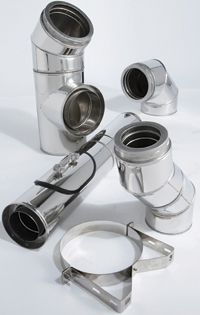Open wood-burning fire and room sealed stoves, and solid biomass boilers are coming on in leaps and bounds but, SFL's Jason Lee warns contractors not to forget the rules about chimneys.
Throughout history wood has been the natural fuel source and it is only in the last 200 years that fossil fuels have taken over as the fuel of choice. Although fossil fuels have had a huge positive effect on our way of life, we are now experiencing the negative effect in the form of global warming.
I was told in a rather philosophical way there is a reason why fossil fuels are buried deep underground. For, while they served their purpose during the great industrial revolution in helping to advance our way of life, these fuels were not meant to be sustainable.
Nature has provided us with many sustainable energy sources in the form of wind, sun, tidal, geothermal and wood, the challenge is harnessing and implementing this energy in the most efficient and environmentally sound way. With the effects of global warming more has to be done to reduce carbon dioxide emissions and the only way forward is to change to more carbon-friendly fuels and renewable technologies.
The government under the Climate Change Act (2008) requires that by 2050, the UK's annual CO
2 emissions should be reduced by 80 per cent compared with 1990 levels.

SLF's Nova chimney range
Currently home energy emissions are responsible for more than a quarter of UK CO
2 emissions. It also has to be considered that no renewable solution should be looked at in isolation, but considered as a part in the overall solution. Complementary technologies such as solar, wind, ground/air source heat pumps and biomass should be considered within the overall design of the heating/energy system.
Virgin wood
One fuel that has seen resurgence as a carbon-friendly fuel source is virgin wood, either in the form of traditional logs or biomass alternatives such as pellets or chippings. Pellets are a renewable, clean burning biomass fuel made from recycled wood waste or sawdust; while wood chips, although less controlled in their production are also made from recycled waste. Wood is classed as carbon neutral on the basis that the amount of CO
2 absorbed into the tree during its life is balanced by the amount of CO
2 emitted when burnt or left to rot.
Open wood burning fires are estimated to be only 20-25 per cent efficient, while a modern wood burning stove can run at more than 80 per cent efficiency and contribute to the ambience of the room. Further advances in technology have led to room-sealed stoves, which duct their combustion air from outside of the building, reducing air infiltration. Other technologies include biomass/pellet appliances which offer superior efficiency and controllable output.
While such advances are great, the one thing often overlooked is the chimney. With the rapid introduction of these new technologies, it is often found that standards, codes of practice, Building Regulations and even the appliance manufacturers installation instructions fall short on the advice offered.
It is still widely accepted solid biomass appliances are no different from any other solid fuel appliance in respect to the chimney design, sizing and height requirements. This is not strictly true.
It cannot be assumed the internal diameter of the chimney will be the same as the outlet on the appliance. This will depend on the route and resistances within the chimney system and the combustion characteristics of the appliance. Further considerations such as appliance draught tolerances have to be factored into the chimney design together with the chimney performance over the full output range of the appliance.
Critical
It is this design relationship between the chimney and appliance which is critical for the correct performance and efficiency of the appliance and to ensure correct venting of the combustion products. To ensure correct sizing of the chimney, SFL uses computer modelling (iSize) to determine the flow and thermal dynamics of the system to BS EN 13384-1, ensuring optimum performance and economic product selection.
Chimney heights for biomass appliances are also another grey area. Because of the potential for particulates in the flue gas, more local authorities require detailed dispersal models to be undertaken as part of the planning requirement, usually using the AERMOD or ADMS 4 model.
Although the sizing and design of the system are critical, equal importance must be given to the actual chimney product employed for the application.
Because of the efficiency and wide output range, the flue gas temperature will be in the region of 70°C-180°C, much lower than traditional solid fuel appliances. For this reason a well-insulated chimney is essential for rapid draught stabilisation and preventing the combustion products falling below their dew point.
The chimney product must also have soot-fire resistance, in case of a chimney fire.
The Nova chimney system, manufactured by SFL is CE Marked to BS EN 1856-1 T450 N1 W V2 L50050 G(50). It is rated for flue gas temperatures up to 450°C as standard, and conforms to the pressure/leakage requirement of N1 when tested to a positive pressure of 40Pa.
Manufactured with a fully welded 0.5 mm 1.4404 (316L) liner independently tested to corrosion class V2 wet and with a 25 mm high density insulated annulus, Nova SM offers a very high thermal and corrosion-resistant specification. Soot-fire resistance is indicated by the G(50) classification indicating the product has been tested at 1,000°C for 30 mins at a distance to combustible material of 50 mm. With retrofitted seals, Nova SM has full condensate and pressure resistance up to 200Pa (P1), with the performance designation of BS EN 1856-1 T200 W P1 V2 L50050 O (50).